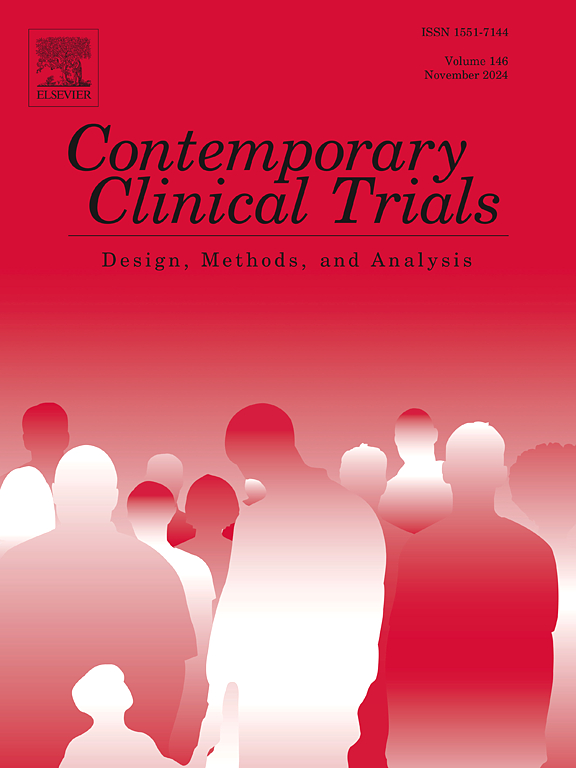在两阶段临床设计中使用多种生物标志物进行患者富集。
IF 1.9
3区 医学
Q3 MEDICINE, RESEARCH & EXPERIMENTAL
引用次数: 0
摘要
浓缩策略在现代临床试验设计中起着至关重要的作用,特别是随着精准医学对患者特异性疗效的关注。通过针对最有可能受益的生物标志物定义的人群,这些策略提高了效率,减少了样本量和成本,加快了时间表,并最大限度地减少了不必要的治疗相关风险和副作用。最近在富集设计方面的发展引入了生物标志物随机性,并解释了处理效果与生物标志物之间的相关结构,从而产生了两阶段阈值富集设计。然而,现有的方法仅限于单一的连续生物标志物。虽然结合多种生物标志物可以提高目标群体识别的准确性,但由于确定多个阈值的挑战,没有研究研究如何将多种连续生物标志物纳入富集设计中。为了充分利用所有相关生物标志物的信息,我们提出了能够处理两个或多个连续生物标志物的新型两阶段富集设计。我们的框架包含两种流行的治疗效果度量,包括平均治疗效果(ATE)和标准化ATE。我们使用一项涉及早期阿尔茨海默病患者的假设临床试验来说明我们的方法,并通过模拟研究评估第一阶段样本量对阈值估计的影响。总的来说,我们提出的两阶段富集设计为研究人员整合多个连续生物标志物提供了更大的灵活性。本研究结果为富集试验方法的发展提供了有价值的见解。本文章由计算机程序翻译,如有差异,请以英文原文为准。
Using multiple biomarkers for patient enrichment in two-stage clinical designs
Enrichment strategies play a critical role in modern clinical trial design, especially as precision medicine advances the focus on patient-specific efficacy. By targeting biomarker-defined populations most likely to benefit, these strategies improve efficiency, reduce sample sizes and costs, accelerate timelines, and minimize unnecessary exposure to treatment-related risks and side effects. Recent developments in enrichment design have introduced biomarker randomness and accounted for the correlation structure between treatment effect and biomarker, resulting in a two-stage threshold enrichment design. However, existing methods are limited to a single continuous biomarker. While incorporating multiple biomarkers can improve the accuracy of target population identification, no study has examined how to incorporate multiple continuous biomarkers into enrichment designs due to the challenges in determining multiple thresholds. To fully utilize information from all relevant biomarkers, we propose novel two-stage enrichment designs capable of handling two or more continuous biomarkers. Our framework accommodates two popular treatment effect metrics including average treatment effect (ATE) and the standardized ATE. We illustrate our method using a hypothetical clinical trial involving early-stage Alzheimer’s patients and assess the impact of stage one sample size on threshold estimation through a simulation study. Overall, our proposed two-stage enrichment designs offer researchers greater flexibility in integrating multiple continuous biomarkers. The findings from our study provide valuable insights for the advancement of enrichment trial methodology.
求助全文
通过发布文献求助,成功后即可免费获取论文全文。
去求助
来源期刊
CiteScore
3.70
自引率
4.50%
发文量
281
审稿时长
44 days
期刊介绍:
Contemporary Clinical Trials is an international peer reviewed journal that publishes manuscripts pertaining to all aspects of clinical trials, including, but not limited to, design, conduct, analysis, regulation and ethics. Manuscripts submitted should appeal to a readership drawn from disciplines including medicine, biostatistics, epidemiology, computer science, management science, behavioural science, pharmaceutical science, and bioethics. Full-length papers and short communications not exceeding 1,500 words, as well as systemic reviews of clinical trials and methodologies will be published. Perspectives/commentaries on current issues and the impact of clinical trials on the practice of medicine and health policy are also welcome.

 求助内容:
求助内容: 应助结果提醒方式:
应助结果提醒方式:


